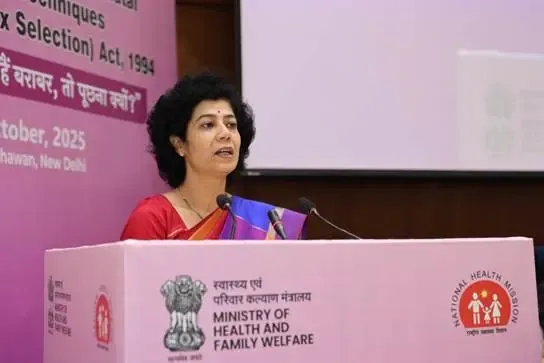Has India’s sex ratio at birth improved to 917 females per 1,000 males in 2021-23?

Synopsis
Key Takeaways
- India's sex ratio at birth has increased to 917 females per 1,000 males.
- The improvement is attributed to the enhanced implementation of the PC&PNDT Act.
- The act serves as both a legal and a moral safeguard against gender-biased sex selection.
- Focus on prevention rather than punishment is essential.
- Online violations represent a significant challenge to enforcement.
New Delhi, Oct 6 (NationPress) The enhancement of the Pre-Conception and Pre-Natal Diagnostic Techniques (Prohibition of Sex Selection) Act has contributed to a notable rise in the Sex Ratio at Birth (SRB), now standing at 917 females per 1,000 males for the period 2021-23, as reported by Aradhana Patnaik, Additional Secretary & Mission Director (NHM) at the Ministry of Health and Family Welfare.
During a National Sensitization Meeting dedicated to reinforcing the PC&PNDT Act, she underscored the advancements achieved in the SRB over the past decade.
"The nation has seen a commendable improvement in the Sex Ratio at Birth. According to the Sample Registration System (SRS) Report 2023, the SRB has surged by 18 points, rising from 819 females per 1,000 males between 2016-18 to 917 females per 1,000 males in 2021-23. This indicates significant progress due to enhanced implementation of the PC&PNDT Act and associated interventions," Patnaik stated.
She reiterated that the PC&PNDT Act serves not only as a legal framework but also as a moral and social safeguard against gender-biased sex selection.
"Females possess greater resilience and a more robust immune system, making the survival of a female child more probable than that of a male. Instead of penalizing those engaged in gender-biased sex selection, our emphasis should be on prevention under the PC&PNDT Act. Society and individuals should prioritize having a healthy child over the child's gender," she added.
This meeting concentrated on enhancing the effective application of the PC&PNDT Act in light of new challenges, highlighting the necessity for coordinated efforts to tackle gaps, ensure compliance, and achieve the goals of the legislation.
Additionally, it brought to light the critical issue of online violations and the misuse of modern technologies, stressing the urgent requirement for proactive collaboration with digital platforms and improved compliance mechanisms to maintain the integrity of the Act.









